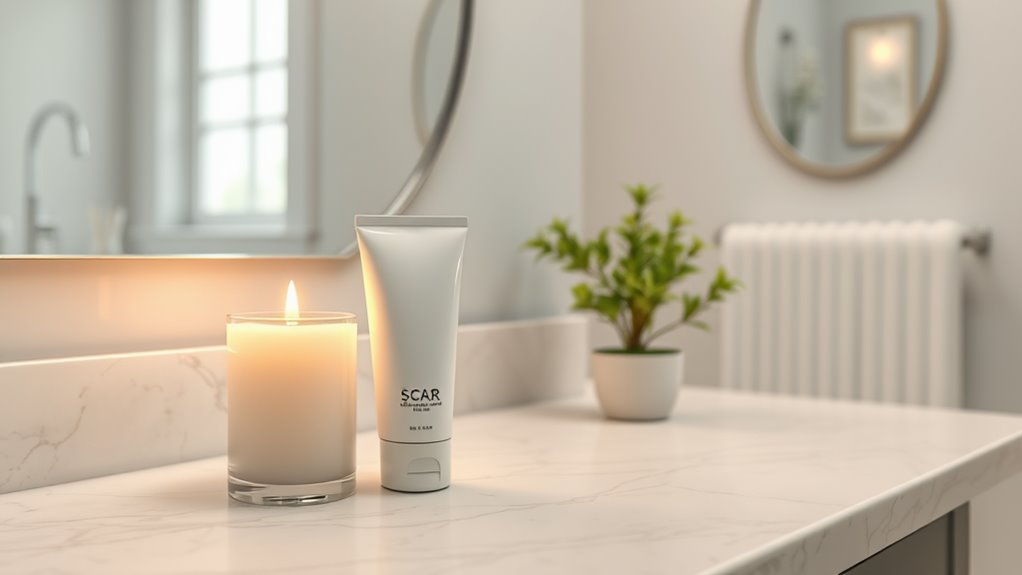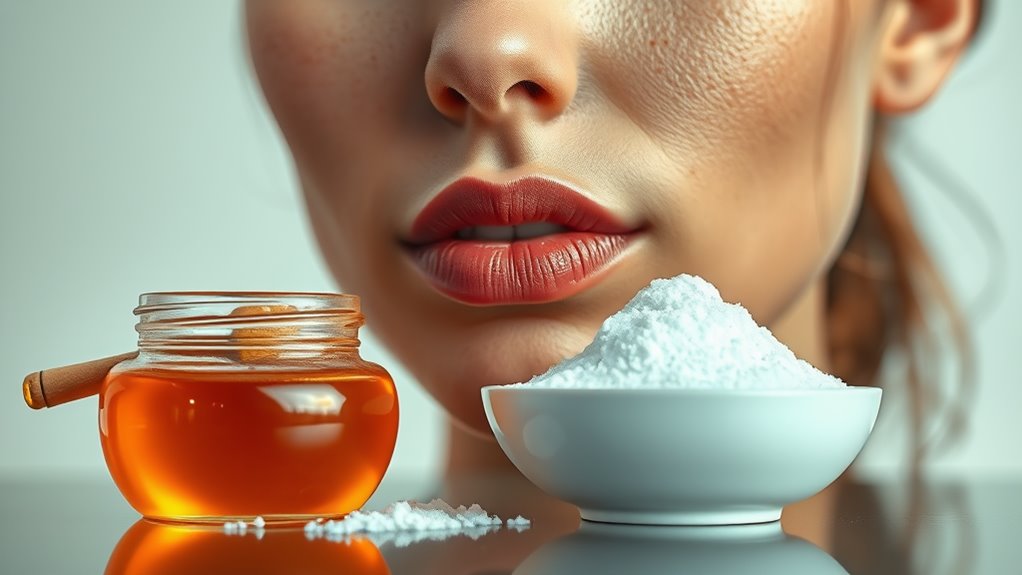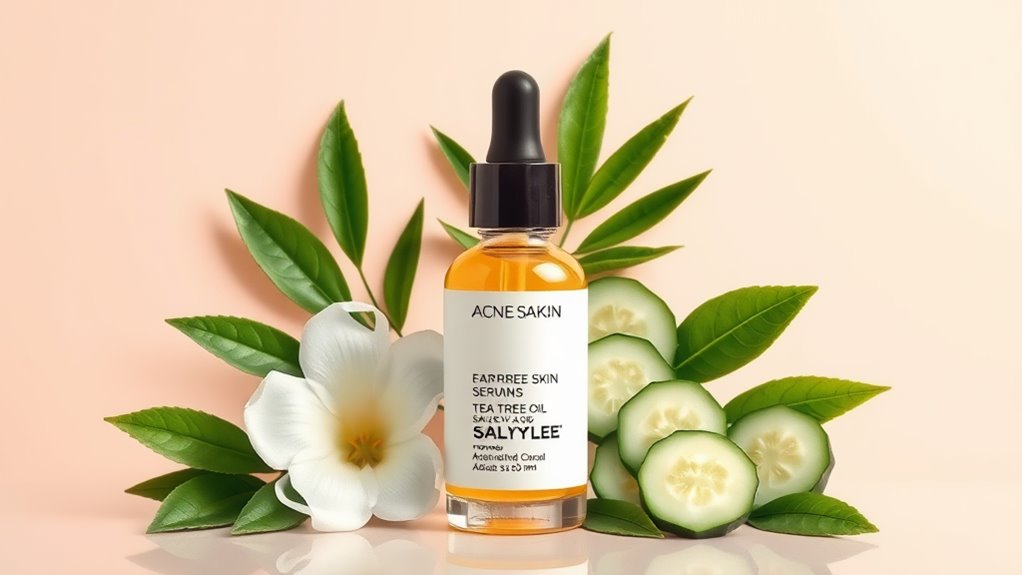How to Control Oil Without Overdrying Your Skin
Dealing with oily skin can be frustrating, especially when you’re trying to control shine without causing dryness. You might think that harsh products are the answer, but that could lead to more problems. Instead, it’s vital to find a balance in your skincare routine. So, how do you effectively manage oil while keeping your skin healthy and hydrated? Let’s explore some essential strategies that can help you achieve that desired balance.
Key Takeaways
- Use gentle, non-stripping cleansers containing salicylic acid or tea tree oil to effectively remove excess oil without drying out your skin.
- Incorporate lightweight, non-comedogenic moisturizers to maintain hydration without clogging pores or adding extra oil.
- Regularly exfoliate 2-3 times a week with gentle chemical exfoliants to prevent dead skin buildup that can lead to increased oiliness.
- Drink plenty of water to keep your skin hydrated from the inside, reducing the need for your skin to produce excess oil.
- Utilize oil-absorbing blotting papers and mattifying powders throughout the day to control shine without disrupting your skin’s moisture balance.
Understanding Oil Production in Your Skin
When you understand how oil production works in your skin, you can better manage it without causing dryness. Your skin naturally produces sebum, which protects and hydrates. However, factors like hormones, diet, and environmental stressors can lead to excess oil.
To control this, incorporate oily skin tips into your routine. Start by using a gentle cleanser to remove dirt without stripping moisture. Opt for lightweight, non-comedogenic moisturizers that hydrate without clogging pores.
Regular exfoliation helps remove dead skin cells, preventing build-up and breakouts. Don’t shy away from oils; instead, choose those that balance your skin’s oil production.
The Importance of Hydration for Oily Skin
Hydration plays an essential role in managing oily skin effectively. When your skin is dehydrated, it often compensates by producing even more oil, leading to a cycle of excess shine and breakouts.
By maintaining optimal hydration levels, you can help balance oil production and promote a healthier complexion. Incorporating lightweight, non-comedogenic moisturizers guarantees your skin receives the moisture it craves without clogging pores.
Additionally, consider drinking plenty of water throughout the day to support your skin from the inside out. Remember, hydrated skin is less likely to overproduce oil, making it vital for achieving that desired balance.
Choosing the Right Cleanser for Oily Skin
Finding the right cleanser for oily skin is essential, as a well-formulated product can help remove excess oil without stripping your skin of its natural moisture.
Look for a cleanser that contains salicylic acid or tea tree oil, which effectively combat oiliness and prevent breakouts. Gel-based cleansers are often ideal, as they provide a deep clean without leaving a heavy residue.
Avoid harsh ingredients like alcohol, which can lead to irritation and over-drying. Always opt for non-comedogenic products that won’t clog your pores.
To maximize effectiveness, cleanse twice daily—once in the morning and once before bed.
With the right cleanser, you’ll strike that perfect balance, ensuring your skin stays fresh and clear without feeling parched.
Effective Exfoliation Techniques
After you’ve selected a suitable cleanser for your oily skin, the next step is incorporating effective exfoliation techniques into your routine.
Exfoliation helps remove dead skin cells, preventing clogged pores and excess oil buildup. Aim to exfoliate 2-3 times a week using a gentle chemical exfoliant, like salicylic acid or glycolic acid.
These ingredients penetrate deep into the skin, promoting cell turnover without the harshness of physical scrubs. If you prefer a physical exfoliant, choose one with fine particles and use it sparingly to avoid irritation.
Always follow up with a toner to balance your skin’s pH. Mastering these techniques will leave your skin smoother, clearer, and better prepared to manage oil effectively.
The Role of Moisturizers in Oil Control
Although you might think that skipping moisturizer will help control oil, the right moisturizer can actually balance your skin’s oil production. A well-formulated moisturizer hydrates your skin without overwhelming it, preventing your sebaceous glands from overcompensating and producing excess oil.
Look for lightweight, non-comedogenic options that offer hydration without clogging pores. Additionally, incorporating humectants can draw moisture into the skin, while emollients provide a protective barrier that locks in hydration. This balance is essential; when your skin feels adequately hydrated, it’s less likely to overproduce oil.
Recommended Ingredients for Balancing Oil
When it comes to balancing oil, certain ingredients stand out for their effectiveness.
Look for salicylic acid, which gently exfoliates and prevents clogged pores. Niacinamide is another powerhouse; it regulates sebum production while improving skin texture.
If you want to harness the power of botanicals, tea tree oil offers antibacterial properties that help keep breakouts at bay. Clay, particularly kaolin, absorbs excess oil without stripping your skin’s natural moisture.
Additionally, consider incorporating witch hazel, known for its astringent properties that can tighten pores.
Finally, lightweight, oil-free moisturizers containing hyaluronic acid hydrate without adding excess oil.
Tips for Maintaining a Matte Complexion Throughout the Day
To keep your complexion matte throughout the day, start by selecting lightweight products that won’t weigh your skin down.
You can also master blotting techniques to help absorb excess oil without disturbing your makeup.
These simple steps can make a big difference in maintaining that fresh, shine-free look.
Choose Lightweight Products
Choosing lightweight products is essential for maintaining a matte complexion throughout the day. Opt for oil-free moisturizers and gels that hydrate without adding excess shine.
Look for formulas labeled “matte finish” or “sheer,” as they absorb oil effectively while keeping your skin nourished. When it comes to foundation, choose a water-based or matte foundation that provides coverage without feeling heavy.
Tinted moisturizers or BB creams can also offer a breathable alternative, giving you a natural look. Don’t forget to select lightweight setting sprays or powders that help control shine without caking.
Blotting Techniques Explained
Even with the best lightweight products, you might still find your skin getting shiny as the day goes on. Mastering blotting techniques can be a game changer.
Start by using oil-absorbing blotting papers. Gently press the paper onto your skin, focusing on areas prone to shine, like your forehead and nose. Avoid rubbing, as this can disturb your makeup.
If you prefer, use a clean tissue; fold it and lightly press it against your skin. For added control, consider a mattifying powder applied with a soft brush after blotting.
This technique not only absorbs excess oil but also refreshes your complexion, keeping it looking flawless. Incorporate these methods into your routine to maintain that coveted matte finish effortlessly.
Frequently Asked Questions
Can Diet Affect Oil Production in My Skin?
Absolutely, your diet can greatly influence oil production. Consuming high-glycemic foods and dairy might increase sebum, while a balanced intake of healthy fats, antioxidants, and hydration can help keep your skin in check.
Is It Safe to Use Clay Masks Regularly?
Using clay masks regularly can be safe, but moderation’s key. You should monitor your skin’s response, as overuse might cause irritation. Aim for once or twice a week to maintain balance without compromising hydration.
How Often Should I Exfoliate Oily Skin?
You should exfoliate oily skin 2-3 times a week. This frequency helps remove dead skin cells and excess oil without causing irritation. Adjust based on your skin’s response, ensuring you maintain a healthy balance.
Are There Specific Sunscreens for Oily Skin?
Yes, there are specific sunscreens designed for oily skin. Look for lightweight, oil-free formulas with matte finishes. Non-comedogenic options can help prevent breakouts while providing essential sun protection without adding extra shine.
Can Hormonal Changes Increase Oiliness in Skin?
Yes, hormonal changes can definitely increase oiliness in your skin. Fluctuations in hormones, like during menstruation or pregnancy, often lead to heightened sebum production, making your skin feel greasier and potentially exacerbating acne concerns.
Conclusion
Controlling oil without drying out your skin is all about balance. By choosing the right cleanser, incorporating gentle exfoliants, and using lightweight moisturizers, you can keep your skin hydrated and healthy. Remember to stay consistent with your routine and drink plenty of water. With these tips, you’ll not only manage excess oil but also maintain a fresh, matte complexion throughout the day. Embrace your skin’s needs, and you’ll see a positive change in no time!





